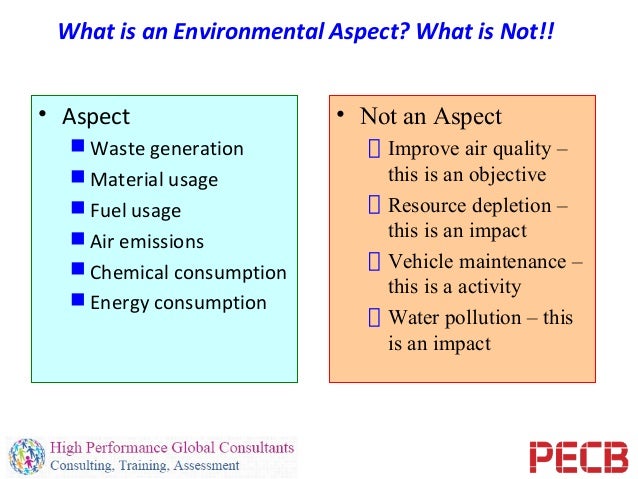- Iso 14001 Management Review Requirements
- Aspect And Impact Register Iso 14001
- Aspect And Impact Register Iso 14001 Requirements Pdf
From August 2017, all new certifications must comply with the ISO 14001:2015 standard, and from September 2018, all certificates according to the old standard ISO 14001:2004 lose their validity. The revised environmental management standard requires businesses to undertake a life cycle perspective of their goods and services. This implies looking beyond one's own processes and considering the entire life cycle within the assessment of the significant environmental impacts. This enables the processes with the dominant environmental impacts to be revealed, which need not necessarily be one's own production process. Depending on the type of product and use, the raw materials, transportation, use phase or disposal may be the main drivers of environmental impacts.
An Aspect and Impact Register is an integral part of any organization's ISO Environmental Management System. It is designed to identify and give significance to sustainability and environmental efficiencies; which are created as a result of the activities and services provided by the organization. What does aspect mean? May 29, 2019 A register of significant environmental aspects is usually produced to meet the requirement to maintain documented information of environmental aspects and associated impacts and of significant environmental aspects. The register must be kept up to date, and will need to be reviewed periodically (e.g. Annually) or when new aspects are. According to ISO, environmental aspects are any activities, services or products that relate to our environment. When the environment is changed, this is an environmental impact, whether the change is beneficial or adverse, and whether it results partly or wholly from the environmental aspects of the organization. Mar 04, 2011 Practical ISO 14001 Aspect and Impact Assessment: Miscellaneous Environmental Standards and EMS Related Discussions: 8: Mar 13, 2002: K: Capturing local government development/planning activities in aspect register: ISO Specific Discussions: 2: Apr 8, 2019: D: Software as risk control - Confused on one aspect of IEC 62304.
Only after taking a holistic approach can the processes with the greatest impacts be identified and measures prioritised, thereby leading to the greatest reductions. In addition, it avoids unknowingly transferring impacts from one stage of the life cycle to another. Even though the organisation does not have direct control or influence over all relevant environmental aspects, it is able to bear a positive influence on the activities connected to its suppliers and service providers. For instance, a life cycle perspective might point towards the significant environmental impacts of a certain good or service occurring during the use phase or disposal. Based on this insight it can identify the most effective solutions, whether these be changes in procurement, product design or better preparation and provision of information regarding the use and disposal for end users.
Minimising risks and seizing opportunities in the spirit of continuous improvement
Environmental considerations play an important role in consumers' purchasing decisions. They also help companies keep their expenditure and overall resource consumption under control. The new ISO 14001:2015 standard recognises the value gained in identifying one's environmental aspects as a means of taking advantage of potential opportunities as well as preparing for future threats. The norm requirement aims to identify positive and negative environmental affects (i.e. one's opportunities and threats) at an early stage, and providing they can be controlled or influenced, that the necessary measures be taken. Game nba 2k13 pc. Aside from reducing risks, the aim is to go beyond solving environmental problems and to assess possible future opportunities. This requirement supports the continuous improvement of an organisation by strengthening its resilience against threats.
The life cycle perspective supports the overriding need to communicate one's environment-related demands to suppliers and service providers, and if desired, to the end users, in order to have an influence that spans across the value chain.
Implementation and outputs
Drawing on its experience in introducing management systems for its clients and in life cycle analyses, Neosys has developed effective methods and tools to help companies apply the life cycle perspective. By looking at processes performed on-site, as well as those occurring upstream and downstream, the relevant environmental impacts can be identified and presented in the form of a matrix (see figure 1). The matrix provides a succinct overview of the relevant resource consumptions, emissions and risks. The evaluation can be based on data supplied by our clients, or where such data is not available, estimated values based on industry averages. In order to provide a meaningful comparison, the semi-quantitative results are classified into high to low impact categories. The degree of impacts are determined by the type of materials and resources used, the amount of it and the environmental impacts associated with it (measured in environmental impact points).
Iso 14001 Management Review Requirements
Although, great detail produces precise results, it is unnecessary to get lost in too much detail, as the effort put in may become disproportionate to the purpose of the exercise. The standard ISO 14001:2015 explicitly mentions that no formal life cycle analysis is required, but merely a careful consideration of the product life cycle. After all, the primary purpose of the exercise is to identify priorities.


Figure 2 shows an example for depicting the opportunities and risk associated with different life cycle stages. They are plotted against the estimated degree to which an influence can be had on the outcome. The resulting graph is often used as an aid for planning improvement measures.
Figure 1: Example of the product life cycle perspective projected onto a matrix
Mac os 10.13 vmware torrent. Figure 2: Example of a risk portfolio for the use phase of a product
Guest blog written by Antoinette Krügel and Mathias Breimesser, Neosys AG Jarvis for pc.
Sources:
ISO 14001:2015 Standard
Aspect And Impact Register Iso 14001
Categories
Aspect And Impact Register Iso 14001 Requirements Pdf
Archives
- 2020
- 2019
- 2018
- 2017
- 2016
- 2015
- 2014
- 2013
- 2012
